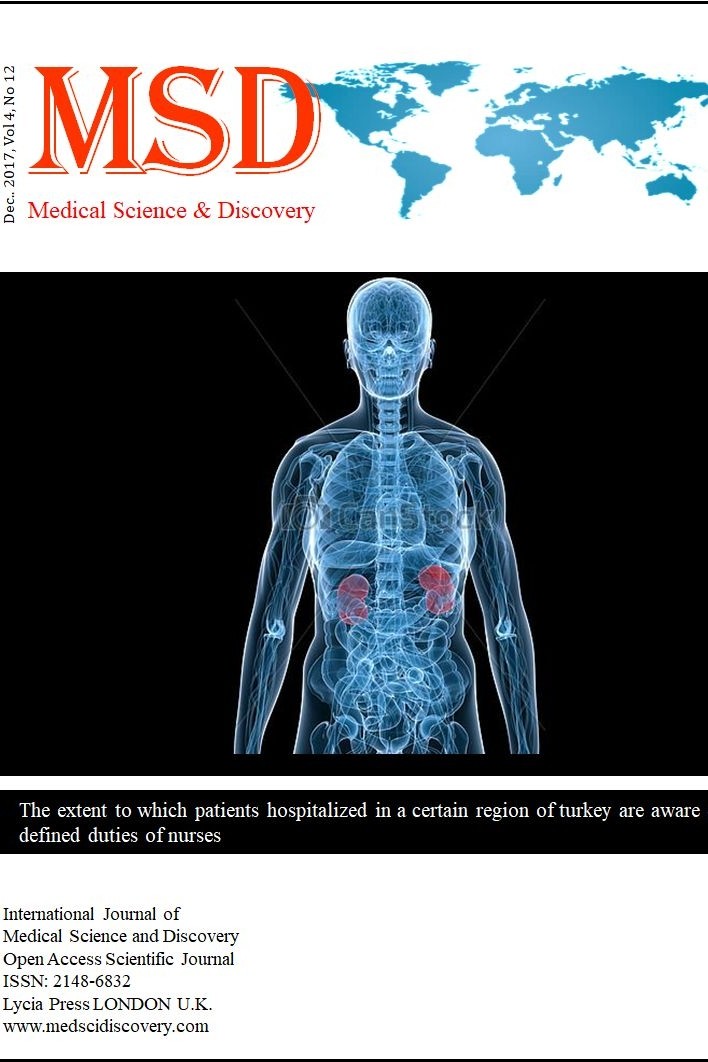Pancreaticoduodenal artery aneurysm: Treatment outcomes of a rare disorder
Pancreaticoduodenal artery aneurysm: Treatment outcomes of a rare disorder
Objective: Pancreaticoduodenal artery aneurysm is a rare vascular disorder that manifests with a clinical presentation ranging from asymptomatic cases to hemorrhagic shock due to aneurysm rupture. In this study, we aimed to evaluate the outcomes of patients treated with different methods for pancreaticoduodenal artery aneurysm. Material and Methods: A total of 5 patients who were treated and followed for pancreaticoduodenal artery aneurysm between January 2011 and January 2018 were enrolled in the study. Standard endovascular embolization and surgical resection were performed. The demographic findings and treatment outcomes were compared. Results: All patients were shown to have a pancreaticoduodenal artery aneurysm by radiological methods. The most common complaint was abdominal pain. The mean aneurysm size was 2.8 cm. Two patients had coeliac axis stenosis and occlusion, one had hypertension, one had Marfan syndrome, and one had chronic pancreatitis as the possible etiological cause. One patient with occlusion of the coeliac axis had thrombus, one patient with coeliac axis stenosis had median arcuate ligament compression. Three patients were treated with embolization, one with surgery, and one with low-molecular weight heparin. Conclusion: Different etiological factors and multiple vascular problems accompanying the disorder create difficulties for establishing a treatment algorithm. Due to the rare nature of the disease, studies available in the literature involve limited numbers of patients, as was also the case in our study. There appeared to be no significant differences between the treatment and follow-up duration among the different treatment methods we applied for our patients.
___
- 1. Stanley JC, Wakefield TW, Graham LM, Whitehouse WM, Zelenock GB, Lindenauer S. Clinical importance and management of splanchnic artery aneurysms. Journal of Vascular Surgery. 1986;3:836-840. doi: 10.1016/0741-5214(86)90059-5.
- 2. Sutton D, Lawton G. Coeliac stenosis or occlusion with aneurysm of the collateral supply. Clinical Radiology. 1973;24:49-53.
- 3. Suzuki K, Kashimura H, Sato M, Hassan M, Yokota H, Nakahara A, Muto H, Yuzawa K, Fukao K, Tanaka N. Pancreaticoduodenal artery aneurysms associated with coeliac axis stenosis due to compression by median arcuate ligament and coeliac plexus. Journal of Gastroenterology. 1998;33:434-438.
- 4. Bracale G, Porcellini M, Bernardo B, Selvetella L, Renda A. Inferior pancreaticoduodenal artery aneurysm associated with common hepatic artery occlusion. The Journal of Cardiovascular Surgery. 1996;37:579-581.
- 5. Moore E, Matthews MR, Minion DJ, Quick R, Schwarcz TH, Loh FK, Endean ED. Surgical management of peripancreatic arterial aneurysms. Journal of Vascular Surgery. 2004;40(2):247–53. doi: 10.1016/j.jvs.2004.03.045
- 6. Armstrong MB, Stadtlander KS, Grove MK. Pancreaticoduodenal artery aneurysm associated with median arcuate ligament syndrome. Annals of Vascular Surgery. 2014;28(3):741-5. doi: 10.1016/j.avsg.2013.06.030.
- 7. Zelenock GB, Stanley JC. Splanchnic artery aneurysms. In: Rutherford RB, ed. Vascular Surgery. 5th ed. Philadelphia (PA): WB Saunders; 2000;1369-82.
- 8. Flood K, Nicholson AA. Inferior pancreaticoduodenal artery aneurysms associated with occlusive lesions of the coeliac axis: diagnosis, treatment options, outcomes and review of the literature. Cardiovascular and Interventional Radiology. 2013;36:578-87. doi: 10.1007/s00270-012-0473-2.
- 9. Takase A, Akuzawa N, Hatori T, et al. Two patients with ruptured posterior inferior pancreaticoduodenal artery aneurysms associated with compression of the coeliac axis by the median arcuate ligament. Annals of Vascular Diseases. 2014;7:87-92. doi: 10.3400/avd.cr.13-00105.
- 10. Kobayashi T, Uenoyama S, Isogai S. Successful transcatheter arterial embolization of an inferior pancreaticoduodenal artery aneurysm associated with coeliac axis stenosis. Journal of Gastroenterology and Hepatology. 2004;19:599-601. doi: 10.1111/j.1440-1746.2003.02894.x.
- 11. Chivot C, Rebibo L, Robert B, Regimbeau JM, Yzet T. Ruptured pancreaticoduodenal artery aneurysms associated with coeliac stenosis caused by the median arcuate ligament: a poorly known etiology of acute abdominal pain. European Journal of Vascular and Endovascular Surgery. 2016;51(2):295–301. doi: 10.1016/j.ejvs.2015.10.025.
- 12. Pereira L, Andrikopoulos K, Tian J, Lee SY, Keene DR, Reinhardt DP, Sakai LY, Biery NJ, Bunton T, Dietz HC, Ramirez F. Targetting of the gene encoding fibrillin-1 recapitulates the vascular aspect of Marfan syndrome. Nature Genetics. 1997;17(2):218–222. doi: 10.1038/ng1097-218.
- 13. Coll DP, Ierardi RT, Kerstein MD, Yost S, Wilson A, Matsumoto T. Aneurysms of the pancreaticoduodenal arteries: a change in management. Annals of Vascular Surgery. 1998;22:286–291. doi: http://dx.doi.org/10.1007/s100169900155.
- 14. Tien YW, Kao HL,Wang HP. Coeliac artery stenting: a new strategy for patients with pancreaticoduodenal artery aneurysm associated with stenosis of the coeliac artery. Journal of Gastroenterology. 2004;39:81-85. doi: 10.1007/s00535-003-1251-3.
- 15. Sgroi MD, Kabutey NK, Krishnam M, Fujitani RM. Pancreaticoduodenal artery aneurysms secondary to median arcuate ligament syndrome may not need coeliac artery revascularization or ligament release. Annals of Vascular Surgery. 2015;29(1):122.e1–7. doi: 10.1016/j.avsg.2014.05.020
- 16. Retzlaff JA, Hagedom AB, Bartholomew LG. Abdominal exploration for gastrointestinal bleeding of obscure origin. JAMA. 1961;177:104-7.
- 17. Egloff L, Rothlin M, Kugelmeier J, Senning A, Turina M. The ascending aortic aneurysm: replacement or repair? The Annals of Thoracic Surgery. 1982;34:117–24. doi: 10.1016/S0003-4975(10)60871-5.
- 18. Plonek T. A meta-analysis and systematic review of wrapping of the ascending aorta. Journal of Cardiac Surgery. 2014;29:809–15. doi: 10.1111/jocs.12448.
- 19. Pecoraro F, Shingaki M, Steuer J, Chaykovska L, Rancic Z, Weber A, Nguyen-Kim TD, Bettex D, Veith FJ, Lachat M. Treatment of isolated ascending aortic aneurysm by off-pump epiaortic wrapping is safe and durable. Interactive CardioVascular and Thoracic Surgery. 2016;23(1):286-291. doi: 10.1093/icvts/ivw103.
- 20. Takao H, Nojo T, Ohtomo K. True pancreaticoduodenal artery aneurysms: A decision analysis. European Journal of Radiology. 2010;75:110–113. doi: 10.1016/j.ejrad.2009.03.041.
- ISSN: 2148-6832
- Başlangıç: 2014
- Yayıncı: Zafer AKAN
Sayıdaki Diğer Makaleler
Pancreaticoduodenal artery aneurysm: Treatment outcomes of a rare disorder
Hüseyin Onur AYDIN, Ebru Hatice AYVAZOĞLU SOY, Fatih BOYVAT, Sedat YILDIRIM, Mehmet HABERAL
Ahmet EROĞLU, Ahmet GÜNAYDIN, Selçuk GÖÇMEN, Serhat PUSAT, Cem ATABEY
Epidural blood patch for the treatment of post dural puncture headache in pregnant women
Orhan BİNİCİ, Ufuk KUYRUKLUYİLDİZ
Antibacterial Activity of Laurus nobilis: A review of literature
